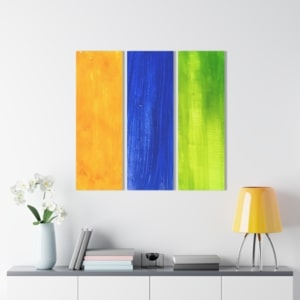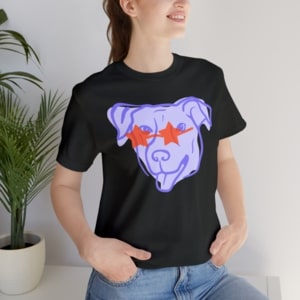Bring your design ideas to life
Dive into the world of online art sales and turn your passion into profit!
We’ll cover everything you need to know about how to sell art online and make money, from choosing the perfect pieces and setting competitive prices to creating a beautiful online store and using print-on-demand.
This post may contain affiliate links, which means we may earn a commission if you make a purchase through those links. This comes at no additional cost to you.
Key takeaways
- Multiple platforms, multiple options: There’s no single best place to sell your art online. The best approach is to use various platforms depending on your art style and expertise, target audience, and desired control.
- Go digital (even for physical art): Digitize your artwork for online sales and POD services. This opens the door to a wider audience and lets you create prints and merchandise featuring your creations.
- Pricing strategy is key: When setting your art prices, consider factors like material costs, time invested, your level of experience, and competitor pricing.
- Marketing is crucial: Building an online presence is essential. Use social media, create a website (or artist profile), and engage with potential customers. Consider email marketing and influencer collaborations.
- Print on Demand streamlines selling: POD services like Printify handle printing and fulfillment, freeing you to focus on creating and marketing your art. Create a POD store and integrate it with your existing sales channels.
How to make money with art online
Now, let’s explore the step-by-step process to turn your art into a profitable online business.
First, to get some inspiration on how to sell your art online, check out this inspiring video featuring Laura, an artist who’s making a living through online art sales:
Decide what you’re going to sell online
Sell art strategically by considering your ideal buyers, artistic voice, online brand, and where you’ll sell. Other artists, like graphic designers, might find success and complement their income by selling visual assets instead of traditional fine art on other platforms.
Original artwork

While selling original artwork is the most common approach to making money online as an artist, it can also be the most challenging. This applies to a wide range of art forms, from paintings and sculptures to photography, drawings, and digital creations.
Even for established artists, success often hinges on strong online skills, effective networking, and high visibility.
Nowadays, many platforms make it easier to sell art products. Online galleries, art platforms, social media, and website builders provide resources for creating effective marketing strategies and reaching potential customers.
Art prints (reproductions)
Conveniently sell art prints or reproductions of original art in an online gallery or independently using a print-on-demand service.
Artists who sell art prints on different platforms have increased visibility to an existing audience. However, these platforms can come with subscription fees and commissions that may be steep, especially for new artists.
Merchandise
In addition to custom canvas prints, posters, and reproductions, independent artists can earn money selling customized merchandise like t-shirts, mugs, phone cases, or other items that fit their niche. This merchandise can also be distributed as branding in live events, art fairs, and gallery exhibitions as souvenirs.
Digital art

Both professional and hobbyist artists can create a good source of passive income by selling digital files, downloadables, or printables.
These digital prints range from fine art reproductions for online sales and galleries to printables that meet everyday needs, like graphic elements.
You can also sell your art as NFTs on specialized platforms like OpenSea or Binance, and market it on social networks.
Tip
Our blog has more information about NFT merch and how to sell prints online, as well as more on selling digital art.
Custom art

For centuries, commissions have been a way for artists to earn a living. Today, online platforms like Saatchi Art connect artists with potential clients. Graphic design and illustration commissions often flow through business-focused services.
- Be cautious with commissions. Platforms offer contract resources, and reputable institutions can provide samples. Clearly define prices, payment terms, and artist rights through a written contract.
- Open communication is key. While clients have a say, detailed contracts set boundaries. Include timelines with checkpoints, approval dates, and deadlines.
Start selling artwork online with Print on Demand
Decide where to sell artwork online
Where to sell art online? Deciding where to showcase your work depends heavily on the type of art you create.
Here’s a breakdown of popular art-selling websites, along with their pros, cons, and what you can sell there:
Platforms for digital art and visual assets:
![Gumroad How to sell art online and make money ([bp_year]) 1](https://printify.com/wp-content/uploads/2023/04/Gumroad.jpg)
- Best options: Gumroad (includes NFTs), Society6, Redbubble, ArtStation, AdobeStock, Creative Market.
- Who is it for? Ideal for digital artists and any graphic designer selling downloadable files, prints, or assets.
- What to consider: Each platform caters to a specific audience (e.g., gamers on ArtStation).
- Pros: Easy to upload and sell digital files. Some platforms offer print-on-demand services.
- Cons: Limited control over branding and pricing on some platforms.
- What can you sell? Digital downloads like illustrations, brushes, textures, or stock photos. Some platforms offer print-on-demand merchandise.
2. Specialized art marketplaces:
![Saatchi Art How to sell art online and make money ([bp_year]) 2](https://printify.com/wp-content/uploads/2023/04/Saatchi-Art.jpg)
- Best options: Saatchi Art, Artfinder, Fine Art America.
- Who is it for? Great for artists with fine art, photography, or established artistic styles.
- What to consider: Often caters to a curated audience of art buyers and might require application or jury review. Commissions are around 40% on Saatchi Art and Artfinder, depending on the plans.
- Pros: Potential exposure to serious art collectors and a higher price point for artwork.
- Cons: Can be competitive and have application fees and commissions. Less control over marketing compared to your own standalone website.
- What can you sell? Originals, high-quality prints, and potentially limited edition pieces. Some platforms offer framing and fulfillment services.
3. Art merch marketplaces and platforms
![Society 6 How to sell art online and make money ([bp_year]) 3](https://printify.com/wp-content/uploads/2023/04/Society-6.jpg)
- Best options: Fine Art America, Society6.
- Who is it for? Excellent for artists wanting to sell merchandise featuring their artwork.
- What to consider: Often cater to a broad audience interested in art-related products.
- Pros: Easy to upload designs and leverage print-on-demand services for various products.
- Cons: Less control over profit margins and fulfillment compared to selling directly.
- What can you sell? A wide variety of merchandise, like t-shirts, mugs, phone cases, and home decor featuring your artwork.
Tip
Explore how to sell merch and make money on Spotify on our blog.
4. Website builders and platforms:
- Best options: WordPress + WooCommerce, Shopify, Squarespace, Wix.
- Who is it for? Perfect for established artists seeking to build their own websites, create an online portfolio, and have complete control over their online presence.
- What to consider: Requires technical skills or design expertise (or paid themes) to create a professional website. Handles inventory management and transactions.
- Pros: Maximum control over branding and customer experience. Can offer a wider range of products and extensive customization options.
- Cons: May require more effort and investment to set up and maintain. Building traffic and establishing a customer base takes more time.
- What can you sell? Originals, prints, merchandise, and digital downloads. You have full control over product types and customization.
5. Marketplaces and online retailers:
- Best options: Etsy and eBay
- Who is it for? Ideal for beginners or artists with more commercial or craft-oriented work.
- What to consider: Established marketplaces attract a large audience but can be competitive. Fees and commission structures vary. In some cases, it’s possible to sell art online free of charge.
- Pros: Easy to set up and start selling quickly. Large built-in audience and developed marketing features.
- Cons: Less control over branding and potentially higher fees compared to dedicated art platforms.
- What can you sell? Typically, originals, prints, and merchandise with limitations on customization based on the platform.
Tip
Check out how to start an Etsy shop on our blog.
6. Social media platforms:
- Best options: Facebook, Instagram, and Pinterest.
- Who is it for? Great for all artists wanting to build a following, connect with collectors, and showcase their work.
- What to consider: Requires consistent engagement and content creation to build a successful presence.
- Pros: Free to use, allows direct interaction with potential buyers, and leverages the power of social media trends.
- Cons: Limited functionality for selling directly (often requires directing customers to another platform).
- What can you sell? Primarily for showcasing work and driving traffic to your main sales channel. Can be used for promotion and limited sales (e.g., through Instagram checkout).
So, what is the best website for selling art?
It’s a balancing act. The best sales channel is often a combination of all these options. Consider your artistic style, target audience, and desired level of control when making your choice. Experiment and see what works best for you.
Price and market your artwork and art business

Thriving as an independent artist requires a shift from solely creative expression to becoming an “artpreneur” – a business owner managing a company. This involves mastering how to price your art products, market them, and gain visibility on search engines.
Let’s take a look at some essential points to help you become a successful business owner without losing your artistic focus.
Pricing
Pricing your art can feel tricky. You want to represent your work’s value while attracting potential buyers. Here’s a breakdown of factors to consider and a popular pricing formula to get you started:
1. Know your costs:
- Fixed costs: This includes studio rent, supplies (paint, brushes, canvases), software licenses (if applicable), and website maintenance fees (if you have your own website).
- Variable costs: These are costs directly tied to a specific piece of art, like the materials used to create it (paint, canvas, frames) and any printing or framing fees if you use a service.
2. Consider your time and expertise:
- Factor in the time it takes you to create a piece. How much does your hourly wage translate to for this artwork?
- Your experience and reputation as an artist also play a role. As you gain recognition, you can justify higher prices.
3. Research the market:
- Look at what similar artists are charging for works of comparable size, style, and medium. This will give you a good baseline for your pricing.
- Explore online art galleries and marketplaces to understand current market trends.
4. Flexibility
- Offer a range of prices: Attract a wider audience by offering a range of art for different budgets.
- Be willing to negotiate: When starting out, be open to reasonable price negotiations, particularly for larger or more expensive pieces.
5. Pricing formula
One popular formula for pricing art is based on the size of the artwork, your material costs, the time invested, and a multiplier reflecting your reputation:
Price = (area of artwork x price per unit area) + (material cost x 2) + (time spent x hourly rate) x reputation multiplier
- Area of artwork: This can be calculated in square inches or centimeters.
- Price per unit area: The value you assign to your artwork per unit of size. It reflects your experience, style, and the overall value you place on your work. Start with what you find through market research and adjust based on your factors.
- Material cost x 2: This ensures you compensate your material costs and factor in a profit margin.
- Time spent x hourly rate: Assign yourself a fair hourly wage and multiply it by the time you spent creating the artwork.
- Reputation multiplier: As your experience and recognition grow, this multiplier can increase (e.g., 1.0 for emerging artists, 1.2 for established artists, 1.5 for well-known artists).
Tip
Learn more about POD and dropshipping profit margins on our blog.
Marketing
Use all the marketing tools provided by your sales channels that you can manage consistently and adequately to market your artwork, brand yourself, and, ultimately, sell your art.
That includes social accounts that resonate with your customer base, a personal website, a blog, and a YouTube channel. Consider other strategies, such as email and influencer marketing.
- Learn from other artists with an online presence, regardless of age and artistic experience. Adapt when necessary, but keep your own voice and originality.
- Network and develop relationships within the artistic community. Participate in physical art events and stay in the loop, online and in person.
Tip
Go deeper and explore more on how to start selling art on our blog – from how to make money as an artist to broadening your reach with podcast merch.
Start selling artwork online with Print on Demand
How to sell artwork online with Print on Demand
Print-on-demand (POD) services offer a fantastic way to sell your art online with minimal upfront investment. With this business model, a printing company (aka “Print Provider”) applies your custom design to the merch only after a customer orders the product from your online store.
This method frees artists from handling inventory and calculating shipping costs, saving more time for creativity and implementing marketing strategies. It also expands an artist’s reach worldwide.
Follow these steps to create a POD store with Printify. Remember, you need a sales channel beforehand.
1. Digitize your artwork
Canvases, posters, and other print-on-demand products have specific design prerequisites such as available colors, print techniques, and measurements. Check Printify’s Design Guide for key requirements and get acquainted with our free merch maker to get the most out of your creations.
Tip
Artists starting in the digital world may benefit from tips on digitizing images.
Also, check out our video tutorials for more actionable information.
2. Connect your own online store
You can create up to five free stores with Printify, add products, and integrate them with your preferred sales channel.
3. Pick and create your products
After you’ve created an online art store, choose your first product in our Catalog and check the Print Providers and the product characteristics. When you decide which to pick, click Start Designing to customize the merch with our Product Creator.
- Upload custom designs, create slogans, or use the Shutterstock integration to customize the merch. Preview it, make any adjustments, and hit Save.
- Edit the profit margins, prices, and descriptions, and review if everything is alright before publishing the final product.
4. Publish your products
Click Publish to synchronize the product with your online store. Depending on the sales channel, additional tweaking may be required directly on the platform.
Pay attention to any customizations possible on the platforms, as they’ll impact the SEO and your product visibility.
FAQ
There’s no single answer to this, as profitability depends on factors like:
- Demand: Art that appeals to a broad audience or a specific niche with strong buying power can be profitable.
- Price point: Higher-priced originals can be more profitable, but prints and merchandise can also generate good income if priced and marketed effectively.
- Production costs: Consider the materials and time needed to create a piece; artwork with lower production costs allows for higher profit margins.
The best site depends on your art style, target audience, and desired level of control. Here’s a breakdown:
- For established artists: Consider website builders like Shopify or Squarespace for full control and branding.
- For beginners or commercial art: Marketplaces like Etsy or Amazon offer a large audience but potentially higher fees.
- For digital art: Platforms like Redbubble or Gumroad are good for selling downloads and some print-on-demand options.
- For fine art: Explore curated marketplaces like Artfinder or Saatchi Art, but be prepared for application processes.
Selling art online for beginners, both online and in physical galleries, may be challenging. Check the following tips to make the process smoother:
- Start with a strong online presence: Create a professional artist website or social media profiles showcasing your work.
- Choose the right sales channel(s): Consider factors like audience, fees, and control level when selecting an eCommerce platform.
- Price your art competitively: Research similar artists and factor in your costs and expertise.
- Actively market your art: Engage on social media, participate in online art communities, and network with other artists.
- Selling originals: This can be lucrative but may take longer to sell.
- Prints and merchandise: Offer a wider range of products at affordable prices.
- Limited edition prints: Create a sense of exclusivity and potentially higher prices.
- Building a loyal following: Develop relationships with collectors who consistently buy your work.
- Social media platforms: Showcase your work on Instagram, Facebook, or other platforms to build a following and connect with potential buyers.
- Your own website: Create a free website builder and showcase your artwork. However, you’ll likely need paid services for transactions and marketing tools.
Sell prints and merchandise with your own art today
Armed with the knowledge of digitizing your art, exploring online marketplaces, and leveraging helpful tools and platforms like Printify, you’re now ready to thrive in the online art world.
Take your time, cultivate a strong online presence, and watch your artistic journey flourish with the power of the internet.


















